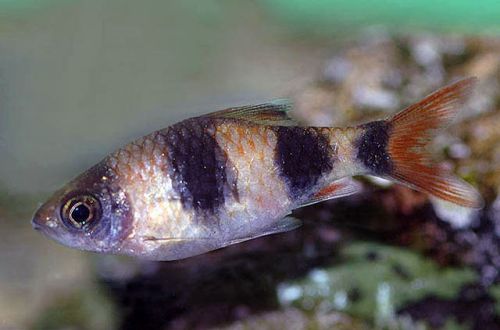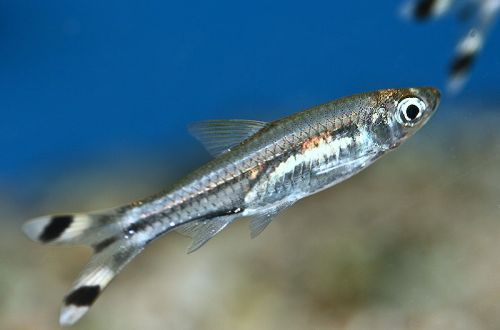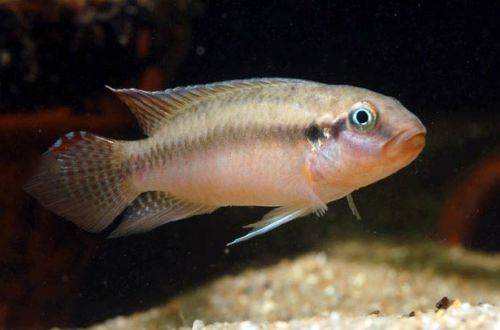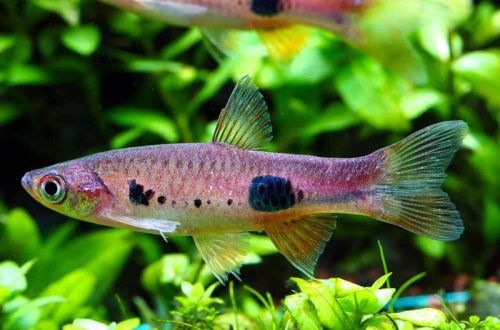
Barbus arulius
Barbus arulius, scientific name Dawkinsia arulius, belongs to the Cyprinidae family. The fish does not have a bright color or original body pattern, but it is very active and interesting to watch. Unpretentious, hardy, easy to keep and breed, so it can be recommended, including beginner aquarists.

Contents
Habitat
It comes from the regions of South India, lives in clean running water with a high oxygen content – these are small streams or rivers with a rocky bottom of gravel, pebbles, stones and boulders. This area is characterized by summer monsoons, which causes significant fluctuations in water levels.
Currently, the natural habitat has been heavily damaged by human activities, which has led to a reduction in wild populations. In some places, the view has completely disappeared.
Description
On a large heavy body of pale color there are dark wide vertical stripes starting on the back and ending closer to the abdomen. The fins and especially the tail have a reddish tint. Males are more intense in color than females, but somewhat smaller in size. With age, white spots-tubercles appear in males in the mouth area, which means reaching puberty.
Food
A balanced diet consists of approximately equal proportions of live and dry food. Barbus arulius will be happy to take bloodworms, daphnia, as well as various flakes and granules. When feeding exclusively dry food, make sure that the composition contains protein components, otherwise there is a high risk of health problems due to a lack of essential trace elements.
Feed 2-3 times a day in the amount eaten in 5 minutes, uneaten leftovers should be removed from the aquarium.
Maintenance and care, arrangement of the aquarium
A flock of medium size (8-10 individuals) will require a tank of about 250 liters. The design uses strong plants with a powerful root system that can withstand strong water flows. Floating plants are excluded. A substrate of stones, boulders, pebbles, sand, due to the same current, is not used. Other decorative elements are installed at the discretion of the aquarist.
Water parameters have slightly acidic values closer to neutral marks, hardness is below average. Read more about pH and dGH parameters and how to change them in the “Hydrochemical composition of water” section.
Fish are very sensitive to the accumulation of organic waste and oxygen deficiency, therefore, when choosing equipment, pay the main attention to the filtration system. You should choose the most efficient filter that is affordable for you, it not only purifies the water, but also creates the artificial internal flow necessary for Barbus arulius to feel most comfortable. Filtration systems often aerate the water, but additional spray stones will not hurt. The rest of the equipment includes a heater and lights, the latter usually supplied with a lid for the aquarium.
Maintenance is reduced to a weekly replacement of part of the water (30–50% of the total volume) with fresh and regular cleaning of the soil from organic waste, as needed, the glass is cleaned of plaque with a scraper.
Behavior and Compatibility
Peaceful active schooling species, content in a group of at least 8 individuals. Compatible with almost all fish of similar size and temperament. It is worth avoiding the introduction of very aggressive large species, as well as small and / or slow ones.
Breeding / breeding
The fish do not show parental care and at the end of spawning can even eat their eggs, so breeding should be organized in a separate tank. The spawning aquarium has a size of about 15–20 liters, the substrate is rocky, covered with a finely meshed mesh, through which the eggs will fall, thereby becoming inaccessible to the parents. Also, dense thickets of small-leaved stunted plants and mosses can be used as protection for offspring. Filling occurs with “mature” water from the main aquarium. Of the equipment, a simple sponge filter is used, the internal flow is not recommended in this case, a heater and an aerator. Lighting can be neglected, spawning occurs in twilight.
The mating season can begin at any time, so the spawning should always be at hand. When you notice that several females have noticeably rounded off, they, along with selected males, are transferred to a prepared tank. At the end of spawning, they are returned back.
The fry appear after 1–2 days, and begin to swim freely after another 24 hours. In the first days of life, feed microscopic food, such as Artemia nauplii, micro worms.
Fish diseases
The main cause of diseases are unsuitable conditions of detention. In turn, a balanced biological system minimizes the risk of their occurrence. Read more about symptoms and treatments in the Aquarium Fish Diseases section.





